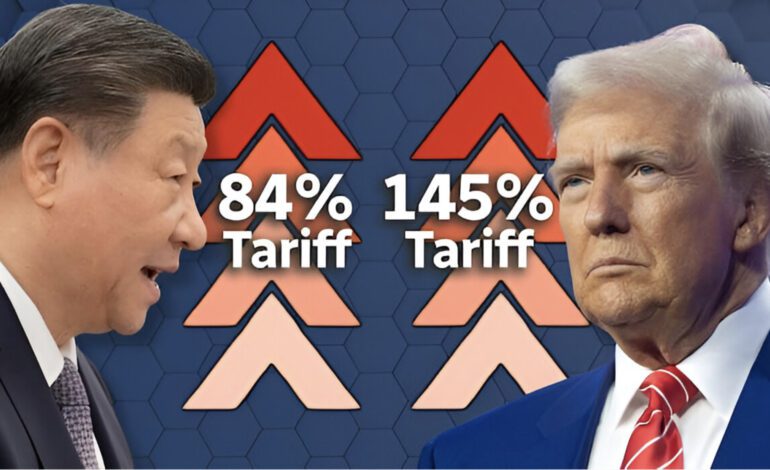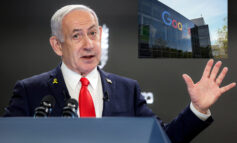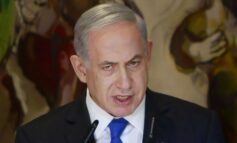WASHINGTON, D.C. – Amid sharp fluctuations in U.S. and global stock markets, President Trump’s trade war — sparked by the imposition of tariffs on imports from nearly every country — took a dramatic turn in the last few days. The confrontation has now become heavily centered on China, after Trump announced a tariff hike to 145 percent on Chinese goods, while suspending high tariffs for 90 days on more than 75 countries willing to negotiate with the U.S., maintaining a baseline tariff of 10 percent on those nations.
Following a sharp drop in U.S. markets just before the new “reciprocal tariffs” took effect, Trump reversed course slightly by suspending additional tariffs above 10 percent on 56 countries, including EU nations, helping U.S. stocks recover most of their losses. He called Wednesday a “great day” due to the market rebound, but warned that the country would face challenges in the “transition” he is leading to “liberate the American economy” and make the world treat the U.S. fairly.
Trump insisted that investors are optimistic about his policies, which he claims have made “everyone eager to reach a deal” on issues like trade barriers, currency manipulation and non-tariff barriers.
Markets surged after Trump’s suspension of extra tariffs, with the Dow Jones Industrial Average rising nearly 3,000 points, the S&P 500 jumping 9.5 percent and the Nasdaq Composite leaping more than 12 percent on Wednesday. However, the gains were short-lived as all three indices dropped again Thursday, driven by a sharp spike in Wall Street’s “fear index” (VIX), which rose by 55.2 percent, hitting 52.18 points.
U.S.-China trade war looms as Beijing vows retaliation to Trump’s new tariffs
The White House confirmed Thursday that the total tariff rate on Chinese goods now stands at 145 percent, following a new increase ordered by Trump in response to Beijing’s retaliatory tariffs of 84 percent on U.S. goods. Trump had earlier raised tariffs on China to 125 percent, building on a prior 20 percent hike over accusations that China was enabling the trafficking of the deadly opioid fentanyl.
Trump claimed China “does not respect global markets”, but said he still expects to reach a good deal, adding that he believes he can come to an understanding with President Xi Jinping. Previously, tariffs were raised on Chinese goods from 54 percent to 104 percent, then to 125 percent, as China responded with reciprocal hikes from 34 percent to 84 percent, vowing to keep “fighting” Trump’s protectionist agenda.
Beijing stated that it has the “determination and tools” to continue the fight if Washington keeps targeting Chinese products.
“We have a trillion-dollar trade deficit with China,” Trump declared at a Sunday press conference. “…If we don’t fix this, there will be no deal.”
While the trade war with China escalates, U.S. Treasury Secretary Scott Bessent said that Trump’s decision to lower tariffs for other countries to 10 percent was not due to the stock market collapse, but because those countries were willing to negotiate.
Global markets took a major hit, with trillions of dollars lost in stock values. Oil prices dropped to a four-year low, and investors pulled out of traditional safe-haven assets like U.S. Treasuries and the dollar.
“We welcome every country willing to negotiate,” Bessent said. “They’ll get the 10 percent tariff, while China’s rate goes up due to its continued escalation.”
He added that Trump’s 90-day window reflects his desire to be directly involved in the negotiations, which will be customized deal by deal — a time-consuming process.
Canada and Mexico are among the countries now facing a 10 percent tariff for 90 days, in addition to earlier tariffs imposed over migration and drug trafficking. Meanwhile, the European Union had imposed 25 percent retaliatory tariffs on U.S. goods, but suspended them for 90 days after Trump took similar action. Nonetheless, the EU still faces U.S. tariffs of 20 percent on most goods and higher rates on cars and steel.
Persistent concerns
Trump remains confident that the trade war will benefit the U.S. in the long term, though he admitted, “it won’t be easy” and called on Americans to “stand strong.” He argued that China will pay a much heavier price if the standoff continues and framed his policy as an “economic revolution” to bring jobs and industries back to the U.S.
Phil Flynn, a senior analyst at Price Futures Group, said the trade war has reached a turning point, with Trump giving countries that want a deal more time.
“What Trump is doing is isolating China economically,” Flynn said.
However, JPMorgan CEO Jamie Dimon warned that Trump’s tariffs could lead to a recession and a wave of debt defaults by borrowers. To avoid this, Trump urged Federal Reserve Chair Jerome Powell to cut interest rates immediately, accusing him of playing political games.
“This is the perfect time to cut rates, Jerome Powell,” Trump wrote in a Truth Social post. “You’ve always been late — but now you have a chance to fix your image, and quickly.”
Powell responded that the Federal Reserve was surprised by the scale of Trump’s tariff increases, warning that their economic impact would be greater than expected. He cautioned that higher tariffs would likely lead to rising inflation and slower growth.
During his first term, Trump imposed tariffs on $380 billion in imports. In his second term, he announced duties on $2.5 trillion worth of imports.
Despite this, Powell said Friday that the Fed is not in a rush to cut interest rates.
“It’s unclear at this time what the appropriate monetary policy path is,” he said. “We need to wait and see how things develop.”






Leave a Reply